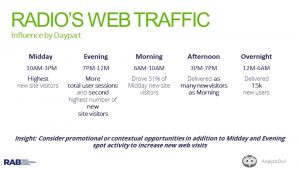
Author: Annette Malave, SVP/Insights, RAB
Recent headlines may have some Americans considering not only who their doctor is, but also when they last saw them – if they have one.
There are many ways to select a doctor or physician of any kind. Health.gov provides a few tips for adults on selecting a doctor. Those tips include asking for recommendations from family, friends or colleagues, as well as checking with insurance providers, considering distance to location and hours. Of course, most doctors have all this information available online, but how do you get them to the site? Radio, of course.
According to the Kaiser Family Foundation, there are nearly 1 million doctors/physicians in the U.S. and nearly half are specialists in some area. Today, one-third of doctors have independent practices and are not part of a medical group or hospital. Regardless of practice size, over 1 billion patients are seen annually by doctors – translating to slightly more than 20 patients each day, according the 2018 Survey of America’s Physicians.
Medical practices, like any business, must work to maintain, as well as grow, their practices. They must also remind their patients of the importance of ongoing care and wellness checks. What better way for a doctor or specialist to reach their patients? Radio, because it reaches 91% of adults who visited a chiropractor and 81% who saw any medical specialist this past year, according to Scarborough.
In an analysis of 75,600 doctor ads throughout 2019, radio drove an 8% increase in immediate lift and overall 83% were new users, based upon data compiled by NumericOwl. “The percentage of new users represents a great opportunity for growth and engagement by using Radio,” stated David Ballinger, founder of AnalyticOwl, parent company of NumericOwl.
On average, radio campaigns in this category delivered 415 new visitors per day and 510 sessions when ads were on air – 29% and 25% lift, respectively, versus days off air.

The greatest activity occurred Tuesday and Wednesday, followed by Thursday. When it comes to dayparts, midday (10 a.m.-3 p.m.) generated the highest number of new visits, followed by evening (7 p.m.-midnight). It may be safe to assume that as people get to work, they realize that it is time to go see a doctor. The midday time period is when radio’s reach has historically peaked.

Selecting a doctor is extremely personal. While adults may search for doctors and physicians the same way that they search for a local establishment, the relationship that exists between a doctor and patient is a very emotional one.
Radio delivers the emotion and the personal connection like no other medium. Medical practices can use radio to drive emotionally engaging stories and patient testimonials. Radio can drive search for doctors/physicians.
To view the full presentation, click here.

